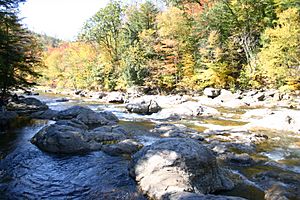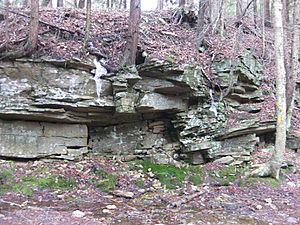Huntley Mountain Formation facts for kids
Quick facts for kids Huntley Mountain FormationStratigraphic range: Late Devonian to Early Mississippian |
|
|---|---|

The Haystacks of Loyalsock Creek in Laporte Township, Sullivan County, Pennsylvania are a quartzite bed of the Huntley Mountain Formation
|
|
| Type | sedimentary |
| Underlies | Burgoon Sandstone |
| Lithology | |
| Primary | sandstone, shale |
| Location | |
| Region | Appalachian Mountains |
| Extent | Pennsylvania |
| Type section | |
| Named for | Huntley Mountain, Lycoming County, Pennsylvania |
| Named by | Berg and Edmunds, 1978 |
Have you ever wondered about the rocks beneath your feet? The Huntley Mountain Formation is a special group of rocks found in Pennsylvania, United States. These rocks formed a very, very long time ago, during the late Devonian and early Mississippian periods. That's about 330 to 380 million years ago! Geologists have studied these rocks to understand Earth's ancient past.
Contents
What is the Huntley Mountain Formation?
This rock formation is made up of two main types of rock: shale and sandstone. Shale is a soft, grayish-red rock that forms from mud and clay. Sandstone is a harder, olive-gray rock made from tiny grains of sand. You can find these rocks mainly in north-central Pennsylvania.
The Mysterious Haystacks
One of the most interesting parts of the Huntley Mountain Formation is called "The Haystacks." These are strange, rounded mounds of quartz sandstone that stick out of Loyalsock Creek in Sullivan County, Pennsylvania. They look like giant haystacks, but they are actually part of a single layer of rock.
The top surface of these mounds is wavy, with some parts rising up to one meter (about three feet) high. Scientists are still debating exactly how these unique mounds formed. It's a bit of a geological mystery!
Where Can You See These Rocks?
You can find good examples, or "exposures," of the Huntley Mountain Formation in a few places:
- Huntley Mountain: The main place where this formation was first described is at Huntley Mountain in Lycoming County, Pennsylvania. You can see it on the side of the mountain, just north of the village of Waterville.
- Loyalsock Creek Gorge: The rocks are also visible at the bottom of the deep gorge in Worlds End State Park.
- The Haystacks: As mentioned, the famous Haystacks are also found in Loyalsock Creek.
How Geologists Study Rock Layers
Geologists often compare different rock formations to understand how they connect across large areas. The Huntley Mountain Formation is thought to be similar to other rock units like the Rockwell Formation and the Spechty Kopf Formation.
Some geologists believe that these formations, including Huntley Mountain, might actually be smaller parts of a much larger rock group called the Pocono Formation. This helps scientists create a clearer picture of Earth's history and how different rock layers formed over millions of years.


